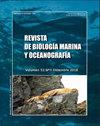与墨西哥中太平洋珊瑚物种有关的细菌组合
IF 0.5
4区 生物学
Q4 MARINE & FRESHWATER BIOLOGY
引用次数: 1
摘要
与珊瑚相关的细菌的功能作用及其对珊瑚健康的贡献在很大程度上仍是未知的。首先,有必要描述珊瑚的微生物组合及其多样性随珊瑚种类、空间和时间的变化。分枝珊瑚(如Pocillopora属)是世界上主要的珊瑚礁建造者。本研究评估了墨西哥中部太平洋6个地点的damicornis孔pora和verrucosa孔pora的黏液和组织以及海水和周围沉积物的细菌结构。利用DGGE和RFLP 16S技术生成带剖面或评估多样性。本研究的目的是评估细菌-珊瑚组合与珊瑚礁环境(每个地点)的环境和空间变量之间的关系。本研究的目的是评估不同的操作分类单元(OTU)的分布情况。每个珊瑚物种以及每个物种的组织和黏液之间都有特定的细菌群。结果表明,优势菌群在底物和位点之间存在差异,仅发现空间差异显著。对珊瑚和海水中主要细菌群变化的环境变量为肉质大型藻类、活珊瑚和海绵覆盖层。相反,沉积物的变化可以用沙子、碎石和岩石的覆盖来解释。《功能主义》(functional)是一部上映于1984年的美国喜剧电影,由约翰·斯特朗(john strand)主演。解决这一知识差距的第一个必要步骤是根据珊瑚微生物组合的特征及其多样性的具体、时间和空间变异。= =地理= =根据美国人口普查,cdp的总面积为,其中土地和(2.641平方公里)水。该研究评估了在墨西哥中太平洋6个地点的夏季和冬季期间,与damicornis和verrucosa Pocillopora的黏液和组织以及海水和周围沉积物有关的细菌。= =地理= =根据美国人口普查,这个县的面积为。还利用多元分析方法评价了细菌-珊瑚组合与珊瑚礁周围环境和空间变量之间的关系。= =地理= =根据美国人口普查局的数据,该县的总面积为,其中土地和(1.)水。Specificity of细菌群体珊瑚was found所species, as well as the组织与粘液of每species。结果表明,细菌优势群在季节之间是相似的,但在站点内的基质之间以及在所有站点的基质之间存在显著的空间差异。环境变量,解释说The variation of The伍德罗细菌groups in corals and sea water是《fleshy coverages macroalgae, live珊瑚和海绵。= =地理= =根据美国人口普查局的数据,这个城镇的总面积,其中土地和(1.)水。本文章由计算机程序翻译,如有差异,请以英文原文为准。
Bacterial assemblages associated with coral species of the Mexican Central Pacific
espanolEl papel funcional de las bacterias asociadas a corales y su contribucion a la salud del coral es aun desconocido en gran medida. Es necesario que primero se caracterice el ensamblaje microbiano del coral y sus cambios en la diversidad a traves de las especies de coral, el espacio y tiempo. Los corales ramificados (e.g., genero Pocillopora) son los principales constructores arrecifales a nivel mundial. Este estudio evaluo la estructura bacteriana asociada al mucus y tejidos de Pocillopora damicornis y Pocillopora verrucosa, asi como del agua de mar y sedimentos circundantes en 6 sitios del Pacifico central mexicano. Se emplearon las tecnicas DGGE y RFLP del ADNr 16S para generar los perfiles de bandeo o evaluar la diversidad. Ademas, se evaluo la relacion del ensamblaje bacteriano-coral con variables ambientales y espaciales del entorno arrecifal (de cada sitio), utilizando analisis multivariados. Se obtuvieron 20 Unidades Taxonomicas Operacionales (OTU) diferentes, siendo los sedimentos los que presentaron mayor numero. Se encontro una especificidad de grupos bacterianos para cada especie de coral, asi como entre el tejido y mucus de cada especie. Los resultados mostraron que los grupos de bacterias dominantes variaron entre sustratos y entre sitios, encontrando, solo una variacion espacial significativa. Las variables ambientales que explican la variacion de los grupos bacterianos dominantes en corales y agua de mar fueron las coberturas de macroalgas carnosas, coral vivo y esponja. En cambio, la variacion en los sedimentos fue explicada por las coberturas de arena, escombro y roca. EnglishThe functional role of coral-associated bacteria and their contribution to coral health is still largely unknown. The first necessary step to address this gap in the knowledge is based on characterization of the microbial assemblage of the coral and the species-specific, temporal and spatial variation in its diversity. Branched corals (e.g., genus Pocillopora), are the main builders of coral reefs worldwide. This study evaluated the bacteria associated with the mucus and tissues of Pocillopora damicornis and Pocillopora verrucosa, as well as that of the seawater and surrounding sediments, in 6 sites of the Mexican Central Pacific during summer and winter seasons. The molecular techniques DGGE and RFLP were used with the 16S rDNA to assess the most abundant bacterial OTUs. The relationships between the bacterial-coral assemblage and environmental and spatial variables of the reef surroundings were also evaluated, using the multivariate analyses. Twenty different Operational Taxonomic Units (OTU) were obtained, with the highest number presented by the sediments. Specificity of bacterial groups was found for each coral species, as well as between the tissue and mucus of each species. The results showed that the bacterial dominant groups were similar between seasons, but these showed significant spatial variations among substrates within sites, as well as per substrate across all sites. The environmental variables that explained the variation of the dominant bacterial groups in corals and sea water were the coverages of fleshy macroalgae, live coral and sponge. In contrast, variation in the sediments was explained by the coverages of sand, rubble and rock.
求助全文
通过发布文献求助,成功后即可免费获取论文全文。
去求助
来源期刊
CiteScore
0.70
自引率
0.00%
发文量
41
审稿时长
12 months
期刊介绍:
Publicar desde una perspectiva científica, artículos originales, decididos por un proceso de revisión por pares, invitando a expertos de reconocido prestigio en el área. Los trabajos publicados se caracterizarán por su solidez teórica-metodológica, actualidad y relevancia para las ciencias marinas.
Se reciben trabajos inéditos derivados de la investigación científica realizada en ambientes marinos y estuarios, en formato de Revisión, Artículos, Notas Científicas, y Obituarios en las siguientes disciplinas::
Biología-Ecología marina
Oceanografía física, química y biológica
Contaminación marina
Geología marina
Sistemática, Faunística y Biogeografía Marina
Manejo Costero
Acuicultura marina
Pesquería marina.

 求助内容:
求助内容: 应助结果提醒方式:
应助结果提醒方式:


